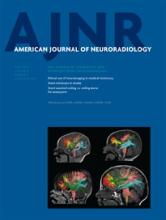Abstract
BACKGROUND AND PURPOSE: Absorbable gelatin-thrombin matrix is increasingly being used in neurosurgical procedures; unlike other hemostats, the stable matrix is left undisturbed and fills the surgical bed after achieving hemostasis. We investigated the immediate postoperative radiographic imaging appearance of the gelatin-thrombin matrix in intracranial operative beds.
MATERIALS AND METHODS: Thirty-one consecutive patients (18 men, 13 women; mean age, 59 years) with 34 surgical cavities, had 31 brain MRIs and 9 head CTs performed ≤ 48 hours postoperatively. They were retrospectively reviewed. Images were evaluated independently by 2 neuroradiologists blinded to the surgical techniques. Surgical beds were evaluated for the presence of the gelatin-thrombin matrix, which appeared as pseudoair material (Hounsfield units ≤ −100) on CT, had characteristic T2-hypointense speckles in a T2-hyperintense background, and demonstrated complete gradient-recalled echo hypointensity on MR imaging. To determine the diagnostic performance of imaging features for the detection of the gelatin-thrombin matrix, the Fisher exact test for the association between imaging features and the presence of the gelatin-thrombin matrix and κ analysis for interobserver agreement were performed.
RESULTS: Hemostasis was achieved with standard methods in 12 surgical beds and with the gelatin-thrombin matrix in 22 beds. Interobserver agreement was substantial. The gelatin-thrombin matrix demonstrated pseudoair hypoattenuation (88% sensitivity, 100% specificity, 90% accuracy; P = .067, κ = 0.74) and distinctive T2-hypointense speckles in a background of T2-hyperintensity (81% sensitivity, 85% specificity, 82% accuracy; P = <.001, κ = 0.76). Combined characteristic T2 speckles and gradient-recalled echo hypointensity increased the specificity (81% sensitivity, 100% specificity, 88% accuracy; P = < .001).
CONCLUSIONS: The unique appearance (pseudoair on CT, T2 speckles with gradient-recalled echo hypointensity) of the gelatin-thrombin matrix should not be mistaken for gossypiboma, pneumocephalus, and/or hematoma.
ABBREVIATION:
- GRE
- gradient-recalled echo
- © 2014 by American Journal of Neuroradiology












